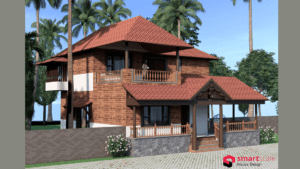Brick masonry is one of the oldest and most reliable construction techniques used worldwide. One of the simplest and most commonly used brick bonding patterns is the stretcher bond. If you’ve ever observed a brick wall where all the bricks are laid lengthwise in a continuous pattern, you’ve likely seen a stretcher bond. But what makes it so popular? How does it compare to other types of bonds like Flemish bond? In this guide, we’ll break down everything you need to know about stretcher bonds in an easy-to-understand manner.
Table of Contents
ToggleWhat is a Stretcher Bond?
A stretcher bond (also called a running bond) is a type of bricklaying pattern where bricks are laid with their long sides (stretchers) facing outward, creating a simple and repetitive design. The bricks are arranged in a way that each row is staggered, meaning the vertical joints in one row align with the center of the bricks in the row above and below.
This bond is mainly used for walls that do not require high strength, such as partition walls, garden walls, and small residential structures.
When Was Stretcher Bond Used?
Stretcher bond has been used for centuries, particularly in the 19th and 20th centuries, when brick construction became widely popular due to industrialization. It became the go-to bonding pattern for non-load-bearing walls and decorative facades. Even today, it remains a preferred choice for modern brickwork in homes and commercial buildings.
What Are the Benefits of a Stretcher Bond?
Stretcher bond is widely used in construction due to its numerous benefits:
Simple Construction: The pattern is easy to lay, requiring minimal brick-cutting and simple alignment.
Economical: Less material waste and faster construction time reduce labor and material costs.
Aesthetic Appeal: Creates a clean, uniform look that works well in contemporary and traditional designs.
Flexibility: Suitable for both internal and external walls, offering a versatile building solution.
Efficient Use of Bricks: Uses whole bricks, avoiding unnecessary cutting and waste.
Easy Maintenance: Any repairs can be easily done without disrupting the overall wall structure.
What is the Difference Between Flemish Bond and Stretcher Bond?
While stretcher bond is simple and straightforward, Flemish bond is more complex. Here are the key differences:
| Feature | Stretcher Bond | Flemish Bond |
|---|---|---|
| Appearance | Only stretchers (long sides) are visible | Alternates between headers (short sides) and stretchers |
| Strength | Weaker, used for non-load-bearing walls | Stronger, used for load-bearing walls |
| Complexity | Simple and easy to construct | More complex and requires skilled labor |
| Brick Usage | Uses full bricks, reducing waste | Requires brick cutting and more materials |
| Cost | More economical | More expensive due to material and labor costs |
Stretcher Bond Uses and Applications
The stretcher bond pattern is commonly used in:
Partition Walls: Non-load-bearing interior walls.
Boundary Walls: Garden walls and fencing structures.
Facade Walls: Decorative exteriors in modern buildings.
Pavements and Pathways: Used in pedestrian walkways and landscaping projects.
Small Structures: Such as sheds, garages, and minor architectural elements.
Stretcher Bond in Brick Masonry
In brick masonry, stretcher bond is one of the most common arrangements. Here’s how it works:
How to Construct a Stretcher Bond Wall:
Foundation Preparation: A strong foundation is required, even though the bond itself is not suitable for load-bearing walls.
Laying the First Course: The first row of bricks is laid with their long sides facing outward.
Staggering the Joints: The next row is placed so that the vertical joints do not align with those below.
Mortar Application: Mortar is applied between bricks to hold them together and improve durability.
Ensuring Leveling: A spirit level is used to ensure even alignment.
Limitations of Stretcher Bond in Masonry:
Not Suitable for Load-Bearing Walls: Since all the bricks are placed lengthwise, it lacks structural strength.
Requires Extra Support: Lintel beams or piers are necessary for stability.
Conclusion
Stretcher bond is one of the most widely used brick bonds due to its simplicity, cost-effectiveness, and aesthetic appeal. While it is not suitable for load-bearing walls, it is perfect for partition walls, facades, and landscaping projects. Whether you’re designing a modern home or a commercial building, stretcher bond is a practical and visually appealing choice.
Looking for Expert House Design Solutions?
At SmartScale House Design, we specialize in creating modern, durable, and efficient house designs tailored to your needs. Whether you’re planning a new home or a renovation, our team is here to bring your vision to life. Contact us today to get started!
FAQs About Stretcher Bond
What Are the Four Types of Brick Bonds?
The four common types of brick bonds are:
Stretcher Bond: Uses only stretchers, ideal for simple walls.
Header Bond: Uses only headers (short sides), stronger than stretcher bond.
English Bond: Alternates between headers and stretchers in each row, providing high strength.
Flemish Bond: Alternates headers and stretchers in the same row, offering both strength and visual appeal.
What Does “Stretcher Bond” Mean?
“Stretcher bond” refers to a brickwork pattern where all bricks are laid with their long sides (stretchers) facing outward, creating a simple and uniform look.
How Many Bricks Per Square Meter?
The number of bricks required per square meter depends on the size of the brick and the thickness of the mortar joints. Typically:
Standard Brick (190mm x 90mm x 90mm): Requires 50 bricks per square meter for a single-layer wall.
Double Brick Wall: Requires around 100 bricks per square meter.
Which Brick Bond is Strongest?
The English Bond is considered the strongest among brick bonds because it alternates between headers and stretchers, providing high structural integrity.









